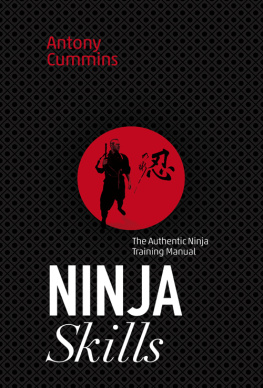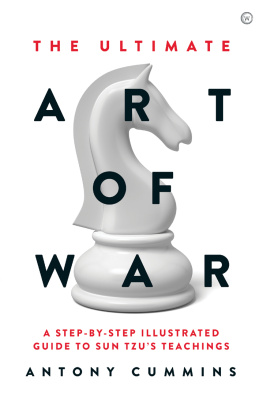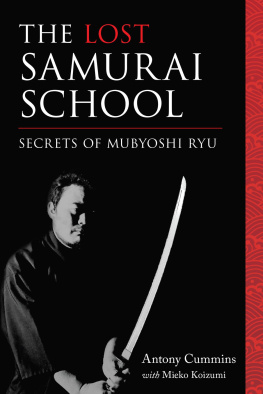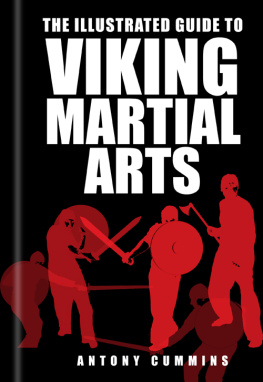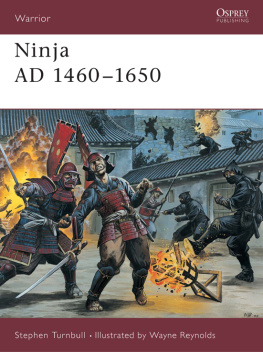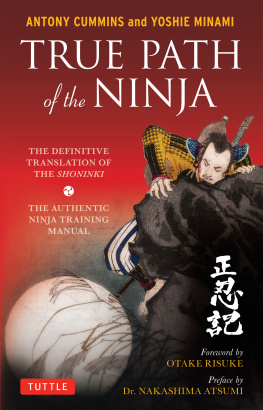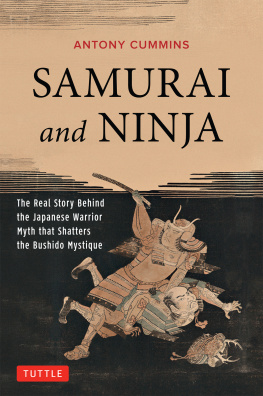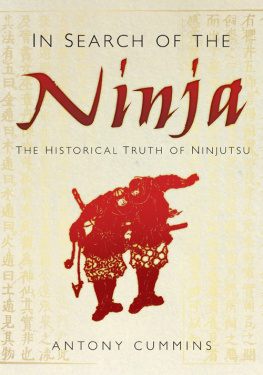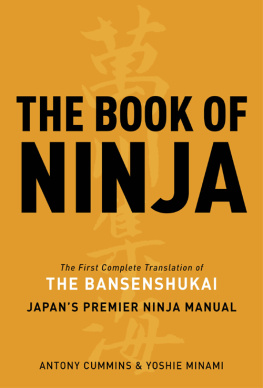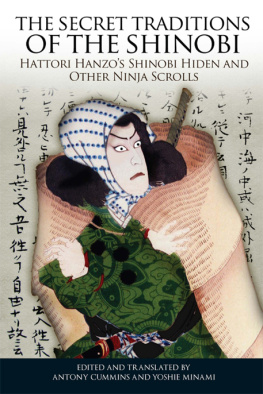Antony Cummins - Ninja Skills: The Authentic Ninja Training Manual
Here you can read online Antony Cummins - Ninja Skills: The Authentic Ninja Training Manual full text of the book (entire story) in english for free. Download pdf and epub, get meaning, cover and reviews about this ebook. year: 2018, publisher: Watkins Publishing, genre: Science. Description of the work, (preface) as well as reviews are available. Best literature library LitArk.com created for fans of good reading and offers a wide selection of genres:
Romance novel
Science fiction
Adventure
Detective
Science
History
Home and family
Prose
Art
Politics
Computer
Non-fiction
Religion
Business
Children
Humor
Choose a favorite category and find really read worthwhile books. Enjoy immersion in the world of imagination, feel the emotions of the characters or learn something new for yourself, make an fascinating discovery.
- Book:Ninja Skills: The Authentic Ninja Training Manual
- Author:
- Publisher:Watkins Publishing
- Genre:
- Year:2018
- Rating:3 / 5
- Favourites:Add to favourites
- Your mark:
- 60
- 1
- 2
- 3
- 4
- 5
Ninja Skills: The Authentic Ninja Training Manual: summary, description and annotation
We offer to read an annotation, description, summary or preface (depends on what the author of the book "Ninja Skills: The Authentic Ninja Training Manual" wrote himself). If you haven't found the necessary information about the book — write in the comments, we will try to find it.
Ninja Skills: The Authentic Ninja Training Manual — read online for free the complete book (whole text) full work
Below is the text of the book, divided by pages. System saving the place of the last page read, allows you to conveniently read the book "Ninja Skills: The Authentic Ninja Training Manual" online for free, without having to search again every time where you left off. Put a bookmark, and you can go to the page where you finished reading at any time.
Font size:
Interval:
Bookmark:
NINJA
Skills
NINJA
Skills
The Authentic Ninja
Training Manual
Antony
Cummins

One who acts on principles, that is what a ninja should be.
Bansenshkai, Fujibayashi-sensei, 1676
Contents
A NOTE ON TERMINOLOGY
The term ninja is correctly interpreted as shinobi no mono (shinobi carries the connotation of hiding and mono means person). This is often contracted to shinobi. The skill of ninjutsu is correctly spoken as shinobi no jutsu, the arts of the shinobi. These are the terms used in the historical scrolls on which this book is based and so these are the terms used here.
Introduction
THE WORLD OF THE SHINOBI
Spanning a millennium, from the 9th to the 19th century, the age of the samurai was a glorious chapter in the chronicle of Japan. The samurai observed a refined and precise etiquette in all their activities, from the taking of tea to the taking of enemy heads. This emphasis on the right way of doing things continues to exert a powerful influence in modern Japanese culture.
Nestled within a samurai force, yet standing apart from it, lurked the shadowy shinobi, the infamous ninja agent. He was the commando, the spy, the betrayer. While standard samurai found lying and cheating repugnant, the shinobi were not bound by such scruples. They too followed an ethical code, but they considered duplicity to be acceptable as long as it was used in the service of their lord. The shinobi soldier would often integrate himself within the enemy, sharing in the rhythms of everyday life and steadily gaining their trust but all the while hiding a malign intent. He was a foul demon obeying the bidding of his gods, enabling the plans of his lord to bear fruit.
WHO WERE THE SHINOBI?
The shinobi were spy-commandos with multiple specialisms, all of which involved clandestine activity. These included espionage, counter-intelligence, surveillance, scouting, infiltration, propaganda, incendiary warfare and physical protection, as well as the capturing of any person targeted for arrest by the lord. An essential part of any Japanese military force, the shinobi were considered by many chroniclers as the eyes and ears of an army.
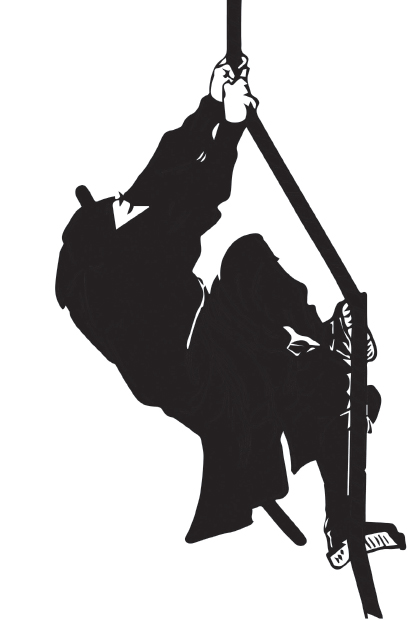
Image of a thief by Edoperiod artist, Hokusai.
Unlike the samurai, which was a specific social class, the shinobi was a paid military role that could be fulfilled by a soldier of any background. Many shinobi were from the samurai class, but others were simple ashigaru foot soldiers. Others still were itinerant monks, actors or tradesmen who might take on a temporary assignment. True shinobi owed their allegiance to a single lord, whether for the length of a short-term contract or across generations. Being a shinobi did not automatically confer any particular status; there were lower-grade shinobi as well as masters of the art (see lessons ).
The shinobi were first recorded in the 14th century. They are believed to have become particularly influential during the turbulent Sengoku period (1467c.1603), when Japan was in a near-constant state of civil war. They then fell into relative obscurity during the more stable Edo period (c.16031868), when the country was largely united under the Tokugawa shogunate. By the time of the Meiji Restoration in 1868, when imperial rule returned in place of military government, the historical shinobi and samurai had died out.
ABOUT THIS BOOK
Ninja Skills investigates the beliefs, tactics and practices of the Japanese shinobi. It draws directly from historical manuscripts, most of which date from the 17th century and were compiled by forward-thinking writers determined to record for future generations the experiences of shinobi who had served during the warring Sengoku period. The chief source for the 150 lessons contained within these pages is the 1676 manual the Bansenshkai, written by Fujibayashi Yasutake. This has been supplemented by quotations and variations from other important works of the period, including the Shninki by Natori Masazumi (Issui-sensei), the Ykan series by Chikamatsu Shigenori, and the Gunp Jiysh by Ogasawara Sakuun Katsuzo.
The lessons build on the original material to explain how, as a modern reader, you can interact with these skills. Commentaries expand upon each teaching, outlining the social, cultural and religious context and practical applications, in order to deepen your understanding of shinobi no jutsu. It is hoped that you will be able to incorporate some of the skills and insights into your own shinobi study. However, the world of the shinobi was very different from ours and some of the practices described are dangerous or illegal or both, and should not be emulated.
The teachings have been selected from all volumes of the Bansenshkai and represent a broad overview of the writing of Fujibayashi-sensei. If you wish to delve more deeply into the source material, the appendices at the back of this book go into further detail about the scrolls and the Chinese military classics on which some of them are based. You can also read an English translation of the full Bansenshkai in The Book of Ninja (Watkins, 2013).
The
Lessons
Fundamental Concepts
Lesson 1
THE PATH OF THE SHINOBI
In our country we use the ideogram shinobi as it has a deep meaning. Without realizing the meaning you will find it difficult to take even the first step on this path.
Bansenshkai, Fujibayashi-sensei, 1676
Those who wish to take the path of the shinobi must first understand the concepts represented by the shinobi ideogram. It carries the following essential meanings: perseverance, forbearance, endurance, secrecy and stealth. Through its use by agents engaged in espionage the ideogram has also come to have the connotations of spy, secret agent, thief and infiltrator.
In the Bansenshkai Fujibayashi-sensei explains that the shinobi ideogram comprises the characters for heart () and blade (), because to plunge themselves deep into the core of the enemy shinobi must forge their hearts into weapons that are hard and sharp like a blade.

A breakdown of the individual characters that make up the shinobi ideogram.
This is not a path for the weak. To venture into the dominion of the shinobi requires enormous self-control and a level of commitment and endurance that most people cannot attain.
What makes the path so difficult is that shinobi must be simultaneously loyal to their own clan and treacherous toward the enemy. They live within samurai society but remain in its shadow, forever close to the centre but always cast to the outside, as any betrayal could mean the downfall of a clan. Consequently, shinobi sit outside the lords light but close enough to feel its warmth. Unlike the average soldier, they do not benefit from the armys protection they do not march within the ranks or camp behind sturdy palisades. The shinobi venture out before all others, alone, and put themselves in danger deep inside the adversarys stronghold.
Next pageFont size:
Interval:
Bookmark:
Similar books «Ninja Skills: The Authentic Ninja Training Manual»
Look at similar books to Ninja Skills: The Authentic Ninja Training Manual. We have selected literature similar in name and meaning in the hope of providing readers with more options to find new, interesting, not yet read works.
Discussion, reviews of the book Ninja Skills: The Authentic Ninja Training Manual and just readers' own opinions. Leave your comments, write what you think about the work, its meaning or the main characters. Specify what exactly you liked and what you didn't like, and why you think so.

